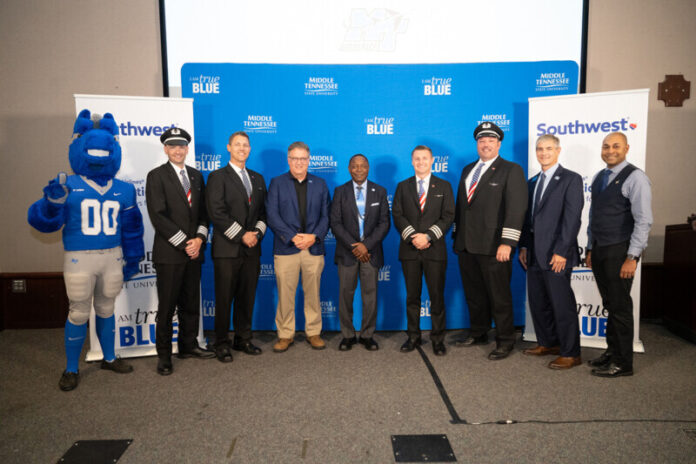
Since 1942, Middle Tennessee State University (MTSU) has had an Aerospace Department that is now a signature program and one of the most respected of its kind in the nation. Staying on the pulse of the industry, the university has been making a point of keeping up with the latest technology and systems to make sure that their students are well prepared to succeed in the aerospace industry. An industry that is currently experiencing a shortage of pilots, a shortage expected to last until 2027, according to skift.com, an AI chatbot that researches news related to the travel industry.
“…[T]he supply-demand gap is projected to last until 2027, with an estimated shortage of about 10,000 pilots,” skift.com notes. “This shortfall is forcing airlines to increase their pay to attract and retain pilots. [Also]…airlines have implemented different strategies to increase the supply of new pilots.”
Keeping up with the latest trends, MTSU officials and Southwest Airlines representatives celebrated the official takeoff of the university’s status as part of the Southwest Destination 225° Pilot Pathways program with a signing ceremony earlier this year. MTSU is part of a prestigious group, as the United States Aviation Academy is also in the program.
With MTSU Aerospace students in attendance, officials, including university President Sidney A. McPhee, signed the ceremonial documents in the State Farm Lecture Hall in the Business and Aerospace Building. The event was followed by an informational session for interested students presented by Southwest pilots representing the Destination 225° program.
Acknowledging “I’m a Blue Raider,” alumnus and Southwest First Officer Chris Collins, who is a Destination 225° lead mentor and will work directly with MTSU Aerospace, said the university “was the bedrock — the foundation to my career all started here. … the inspiration that was given to me by people while I was here drove me to [Southwest].”
On a compass rose, 225° is the southwest heading, and the Destination 225° program provides several pathways designed to meet future aviators at their current experience level and create opportunities to take them to the right seat of a Southwest aircraft. One of those pathways is the university pathway.
With 900 professional flight majors in fall 2022, MTSU aerospace students now have access to a pathway that leads to becoming competitively qualified for a commercial pilot career at Southwest.
Students selected to be in the Destination 225° program will receive guidance, training and quality flying time with Southwest pilots and a direct path to becoming a first officer in as little as two years. This pathway is highly accessible, innovative, cost-effective and one of the fastest routes to flying at a major carrier.
MTSU Aerospace has twenty full-time faculty members, more than 100 flight instructors, and more than 1,000 students, placing it among the largest collegiate aviation programs in the nation. Students from 32 states and 16 foreign countries have been drawn to study there. Aerospace graduates hold responsible positions with companies throughout the United States and internationally.
McPhee said that MTSU has “steadily earned a distinguished reputation as one of the collegiate aviation’s largest and most respected programs in the country” and that Aerospace is the university’s largest academic major.
There are four other programs available under the Bachelor of Science in Aerospace degree at MTSU, including Flight Dispatch, Maintenance Management, Aviation Management, and Aerospace Technology.
The Aerospace Technology program prepares graduates for jobs in research and development. Participants receive rigorous training in mathematics, science, and engineering technology, as well as access to the most up to date research resources. These resources include wind and water tunnels; small unmanned aircraft; flight simulators; and computational fluid dynamics software.
Aviation Management program students learn what is required to keep the nation’s airports, airlines, and other aviation-related companies running effectively and efficiently. They will gain understanding of marketing, business administration, finance and the latest airport management technology.
Maintenance Technicians and Aircraft Repair Station Managers can enter into the aviation industry through MTSU’s Maintenance Management program. Program participants will learn the skills needed to repair and maintain aerospace vehicles, as well as management skills to become industry leaders. They will also earn an Airframe and Powerplant (A&P) Mechanics Certificate from MTSU’s FAA approved-Part 147 Maintenance Technician School.
Flight dispatchers must work with pilots to ensure that every flight reaches its destination safely. Students learn all the variables that can affect a flight, including weather, aircraft performance, federal regulations, and human factors through a NASA-funded high-fidelity simulation lab that replicates a regional airline operations center.
These are all part of MTSU’s ever-growing aerospace program that is moving to the Bomar Field/Shelbyville Municipal Airport (KSYI) due to the Murfreesboro Municipal Airport’s business growth and being land-locked due to the city’s growth.
“Our flight training program started shortly after World War II,” says the MTSU Aerospace website. “Seventy years ago, the program moved to the Murfreesboro Municipal Airport (KMBT), where it has resided ever since. The Murfreesboro Municipal Airport has been a wonderful home for both our flight and aircraft maintenance training programs over the past couple of generations, providing a modern, well-maintained home that has allowed us to grow to our current size… With student demand for the program at an all-time high and a continuing nationwide shortage of new pilots and other aerospace professionals, MTSU must relocate the Aerospace Department, its flight training program, and aircraft maintenance program in order to expand.”















